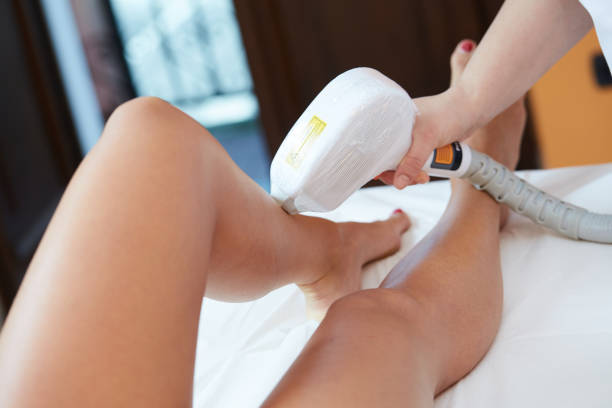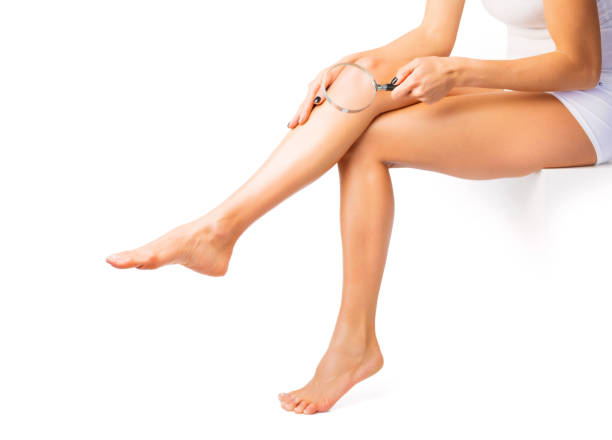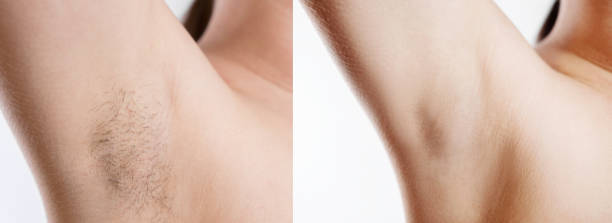IPL
Permanent hair removal - Did you know?
Table of contents
What's the meaning of permanent hair removal? Anyone who has ever had to contend with the unwanted hair on his body, is no stranger to some of these common methods of hair removal which we will go through here. As you will soon see, many of these methods, although practical, will have their drawbacks.
Everyone has body hair, but depending on the season or your personal preferences, you may want to remove some of it.
Contrary to what many stores claim, no hair removal treatment can get rid of hair permanently. However, there are a variety of ways to get rid of it hair for weeks, months or longer periods.
Hair is a normal part of our bodies, but for those trying to get rid of it, options are lacking. To get a little more insight, we consulted three industry experts, Hamish McNair of Candela Medical, celebrity esthetician Lisa Giudi of SKEN by Erase Spa, and celebrity esthetician and author JoElle Lee. (Plus, our own pros speak for it, too permanent hair removal home.)
In this article, we break down the most common hair removal methods, along with the benefits, side effects and effectiveness of each of them.
How fast does hair grow?
According to the American Academy of Dermatology, on average, body hair grows to its full length in about a month. Male hair also tends to grow faster than female hair. Hair on the head can grow about 15 centimetres in a year. Certain factors can affect the rate of hair growth, including nutrition, medications and genetics. The rate of growth can slow down as you get older.
Hair growth is a complex process that begins deep within the hair follicle. Hair depends on blood for nourishment as it makes its way to the skin's surface. The sebaceous glands (oil glands) also play a role in keeping hair smooth and healthy.
Is permanent hair removal possible?


Permanent hair removal - regardless of whether it is in the face eller kroppen inte helt möjligt om du tolkar ”permanent” som för alltid . Enligt McNair finns det ingen metod som tar bort allt oönskat hår permanent dvs för all framtid. ”Snarare är den rätta termen ”permanent hårreduktion ”, säger han. Majoriteten av hårväxt drivs av hormoner, så om balansen mellan hormoner förändras kan detta leda till stimulering av hårsäckarna, vilket leder till ny hårväxt. Med det sagt är saker som elektrolys, laser hair removal and IPL de näst bästa lösningarna för att uppnå en jämn, ”halvpermanent” hårfri hud.
We'll look at each of them, consider how they work as well as their long-term effects.
Different types of long-term hair removal
Below you will find everything you need to know about long-lasting hair removal methods: electrolysis, laser hair removal and IPL.
Electrolysis - Permanent hair removal
”Elektrolys använder en fin nål och elektrisk ström för att värma upp enskilda hårsäckar”, förklarar McNair. ”Detta kan vara en tidskrävande procedur eftersom varje follikel behandlas individuellt, men elektrolys är särskilt effektiv på enskilda gråhår.” FDA anser att elektrolys är en permanent hårborttagningsmetod eftersom den har de bästa övergripande resultaten


This means that through electrolysis permanent hair removal you can get rid of hair for long periods or even a lifetime. However, it is important to note that electrolysis does not give all people permanent results.
You don't really know exactly how it will work for you in a specific area of your body until you've tried it. Nevertheless, if your goal is to never see hair on your body ever again, this may be your best option.
När det gäller smärtnivån konstaterar Giudi att ”Elektrolys är känd för att vara smärtsammare än traditionell laser hair removal. Biverkningarna av rodnad och ömhet är vanligtvis bara tillfälliga, men är vanliga. ”Elektrolys kräver flera sessioner, vilket kan bli dyrt beroende på zonens storlek. Det positiva med det är att det det fungerar med alla hårfärg eller hudtoner.
Laser Hair Removal - Permanent Hair Removal
”Lasertekniken använder en enda våglängd av ljus. Även om det är ett säkert alternativ för de flesta, kanske de med ljus hud och blont hår inte ser de bästa (om några) resultaten. Enligt Lee kan mörkare hudtoner eller färgade personer ha effektiva hårborttagnings- eller reduceringsresultat.
While some laser centers promote the idea of permanent hair removal after a certain number of visits, it is important to understand that there is no laser hair removal equipment that has been approved by the FDA for permanent hair removal. What they have approved, however, are laser hair removal machines for permanent hair reduction because they are effective after consistent, and multiple treatments. The results are always based on the number of your treatments, Giudi notes. If you stop after two or three sessions, you'll only get results for a short period of time.
Hår som växer tillbaka någon gång är fortfarande möjligt – oavsett om det är en reducerad mängd, en finare version eller en kombination av båda. ”För ljusare hudfärger kan man i genomsnitt uppnå 80% minskning av håret med högkvalitativa system efter fyra sessioner”, säger McNair. Efter en fullständig behandling kan resultaten pågå i många år och återväxt ses bara om till exempel hormonbalansen förändras.
IPL - Permanent hair removal
Also known as intense pulsed light, IPL uses a powerful hand-held device to deliver an intense, visible broad-spectrum pulse. When using electrolysis or light-based systems – such as laser or IPL—McNair points out that these methods only affect the anagen phase of hair growth (the active growth cycle). That's why it's necessary to have a series of treatments to permanently reduce hair growth, he says.
Giudi explains that the ideal IPL candidate is traditionally someone with fair skin and dark hair. Side effects can range from redness to swelling.
There are plenty of machines and treatments that promise permanent hair removal. But according to Giudi, results can differ from device to device While most at-home IPL devices are considered safe, they are not all equally powerful and effective, she says.
Recipe creams
If you don't like the idea or cost of electrolysis or permanent hair removal with laser you can talk to your dermatologist about prescription creams.
One type in particular is called eflornitine (Vaniqa), which you apply twice a day for a month. It works by inhibiting the production of enzymes that stimulate hair growth.
According to one study on this treatment, the results can last up to eight weeks, after which you can start all over again. A month's treatment costs around £500.
Eflornithine only works on facial hair and is more suitable for women. Some side effects may include burning, rashes and acne breakouts due to follicular disorders.
Tweezers and waxing
An alternative for smaller areas of the body is tweezing and waxing performed by a certified skin therapist. When hair is removed in this way, it is pulled directly from the root. Depending on how fast your hair grows, the results can last from two to eight weeks.


This is a cheaper option than laser hair removal or electrolysis, but you may need to repeat the treatment more often.
While tweezing can be done on any area of the body, waxing should not be done around the genitals, nipples, ears or eyelashes. You should also avoid applying wax over varicose veins, birthmarks or warts, or on skin that is cracked or sunburned.
The most common side effects of both professional tweezing and waxing are mild rashes and irritation, but this is usually temporary.
Chemical hair removal
This treatment consists of an over-the-counter gel or cream that you put on your skin. It works by weakening a protein in your hair called keratin. This causes the hair to fall out and dry easily.
Depilation does not target the hair follicles, so the results may only last for about two weeks. However, it's an inexpensive option that you can do at home.
Make sure you use the right type of cream for the area where you want to remove hair. Some creams are formulated for the face and others for the body or pubic mound.
It's a good idea to do a patch test on a small area of skin before using chemical hair removal on a larger area of the body. Side effects of this treatment can include chemical burns, rashes and blisters.
The difference between IPL & laser permanent hair removal
IPL and laser permanent hair removal is not exactly the same thing, although they work according to the same principles. In laser hair removal devices, the power of a laser beam is harnessed to heat up a hair follicle until it is sufficiently damaged and no longer viable. Then the hair falls out and growth stops. Over time, use of laser technology can result in reduced, slower or finer hair growth that is less noticeable.
As mentioned, IPL is similar but not exactly the same. In contrast to using the focused laser beam, IPL uses intense pulses of light, usually on the visible spectrum. IPL controls the light emitted to remove shorter wavelengths and so specifically target different structures. In the case of IPL, the light targets the melanin in the hair, which absorbs the energy and heats up, just as with laser therapy. This makes IPL technology a suitable alternative to lasers, and with our IPL device you can use an alternative to laser permanent hair removal at home that offers all the advantages combined with all the options above, with absolutely no disadvantages.
Vivre® IPL laser permanent hair removal
Our proprietary IPL unit is uniquely designed to offer you all the benefits you would expect from any of the above processes and more, without any negative drawbacks. Here is an overview of what you can expect from our Vivre® IPL permanent hair removal.
Effectiveness and long-term laser permanent hair removal
One of the best things - perhaps the best thing - about Vivre® IPL is the fact that it really works. You can use it on any part of the body, including sensitive areas such as the face and the bikini line. It's effective at removing facial and body hair, which is much more than some of the other options we explored can say.
In fact, some creams may be unsafe to use on a part of the body for which they are not intended.
There are no hidden costs and our Vivre® IPL and it never needs refilling. It just needs to be plugged in and running. It's effective on almost all skin types - even darker skin tones - and you can expect to see lasting results in as little as three weeks.
Most importantly, over time you can expect to see less and less hair. Even possibly permanent removal of hair from unwanted areas. Any hair that comes back will be finer and less visible. With repeated treatments, you can get rid of it for good.
Laser permanent hair removal is completely painless and gentle
Unlike so many of the other methods above, the IPL laser permanent hair removal completely painless and gentle. This makes it suitable for all skin types and all parts of the body. Even people with the most sensitive skin will never notice the slightest discomfort from our IPL phone.


Vivre® IPL beskrivas som en ”varm känsla på huden”, som vissa till och med kan säga är trevlig.
It won't dry out your skin and won't leave you at risk of infection or ingrown hairs.
It's even certified safe to use. That means you can get the same kind of treatment you can get in a clinic right in your own home. There have been many studies, both on the effectiveness of IPL treatment but also on its security. Therefore, it has been certified safe to use which only increases its effectiveness.
You can complete a full-body treatment in as little as 30 minutes. With treatments done only once a week, you'll see results in as little as three weeks! With full results within 12 weeks.
Customer satisfaction
Here at Vivre® we take customer satisfaction very seriously. In fact, we put customer satisfaction at the heart of our business model. Because of this, we have taken some additional steps. Mostly to make sure that our products not only work, but that you are completely satisfied with the results.


Vivre® IPL with one year warranty. If something goes wrong within a year, we will gladly replace it. In addition to this guarantee, the lifetime of the Vivre® IPL is estimated to be close to 300,000 pulses. It gives it approximately 10 years of service, depending on how often you use it.
We also offer the 100% satisfaction guarantee on our Vivre® IPL. So if for any reason you are unhappy with its performance, we will happily refund your money. Since our device is designed to produce results within three weeks, you have more than enough time to see if it works for you. We're sure it will.
We know that once you have used Vivre® IPL and see the results, you'll love it. Perhaps for its quick, easy, painless operation and lasting results. Check out our page on our Vivre® IPL, and please contact us at kontakt@vivre.cc if you have any questions about our products.
If you do not get rid of unwanted hair despite treatment with permanent hair removal
If your hair continues to grow out very quickly despite having tried various hair removal treatments, you should make an appointment with your doctor. It could be a symptom of an underlying condition, such as polycystic ovary syndrome (PCOS) or hyperthyroidism.
Inward hair growth is possible with all types of hair removal. In some cases, it can lead to an infection. Follow up with your doctor if you have widespread ingrown hairs or if they have become infected or turned into cysts.
Conclusion
It is perfectly normal to have body hair and removing it is voluntary. Take the time to think about whether you want to remove body hair and for how long.
Despite the many claims, there is no such thing as 100 percent permanent hair removal. Nevertheless, there are solutions for long-term hair removal and ways to limit hair regrowth. Talk to your doctor or dermatologist about the best options for you.

